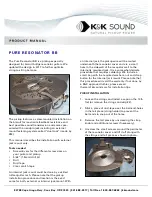
13
Water Bath Attachment
Certain testing applications may require the prism temperature to be maintained
above or below ambient operating temperature. To accomplish temperature
control, the Mark III is supplied with four water ports for connection to a water
bath circulator (Fig 12). Commercial water bath circulators with heating, cooling
or combined capabilities are generally available from laboratory instrument
supply dealers.
Maximum head for water bath attachment should be 5 feet and maximum
pressure 15 psi. The minimum operating temperature of Mark III is 10°C and
maximum is 80°C.
Using tubing having an inside diameter of .25 inches (6.4mm), connect the
output hose from the water bath circulator to either of the water ports on
the lower measuring prism assembly. Attach a second piece of tubing to
the opposite water port, and connect it to either of the upper illuminating
prism water ports. Ensure that this tubing is long enough to allow the upper
illuminating prism assembly to open and close freely. Next attach the return
hose for the water bath circulator to the remaining water bath port (Fig 13).
Tubing choice must consider flexibility. Any tubing that is highly rigid may
apply excessive force on the prism preventing it from closing completely. This
condition can adversely affect reading accuracy.
Note:
If a water bath circulator is attached, care must be used to avoid exposing the Mark III’s prisms to
thermal shock. The ambient prism temperature should be raised or lowered by gradually increasing
or decreasing the temperature of the circulating fluid.
Due to the nature of refractometer thermal efficiency. Controlling the temperature of the instrument
to a temperature above or below ambient, may require the water bath circulator temperature to be
set higher or lower than the desired temperature of the Mark III. The exact temperature setting is
dependent upon circulating fluid type, flow rate, ambient temperature, humidity, etc. Experimentation
may be necessary to determine an appropriate water bath temperature setting to maintain a stable
temperature at the Mark III. The instrument temperature as indicated in the lower left corner of the
display, should be what dictates the water bath temperature setting.
When attempting to determine the appropriate water bath temperature setting. It may be helpful
to have a distilled water sample on the prism to improve thermal conductivity between the
upper and lower prism assemblies.
Fig 12
Fig 13




































